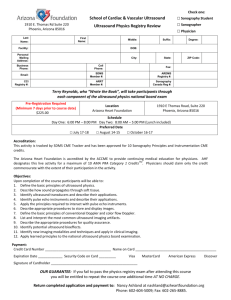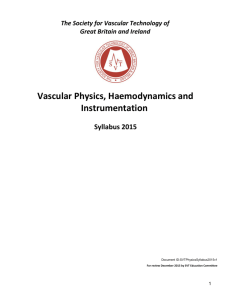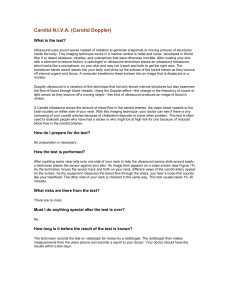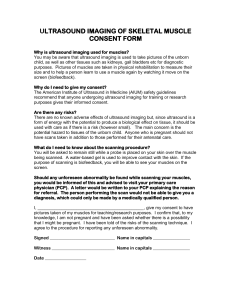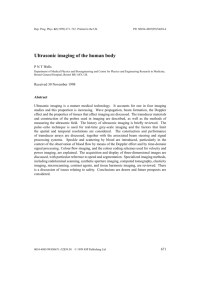Physics, Instrumentation and New Trends
advertisement
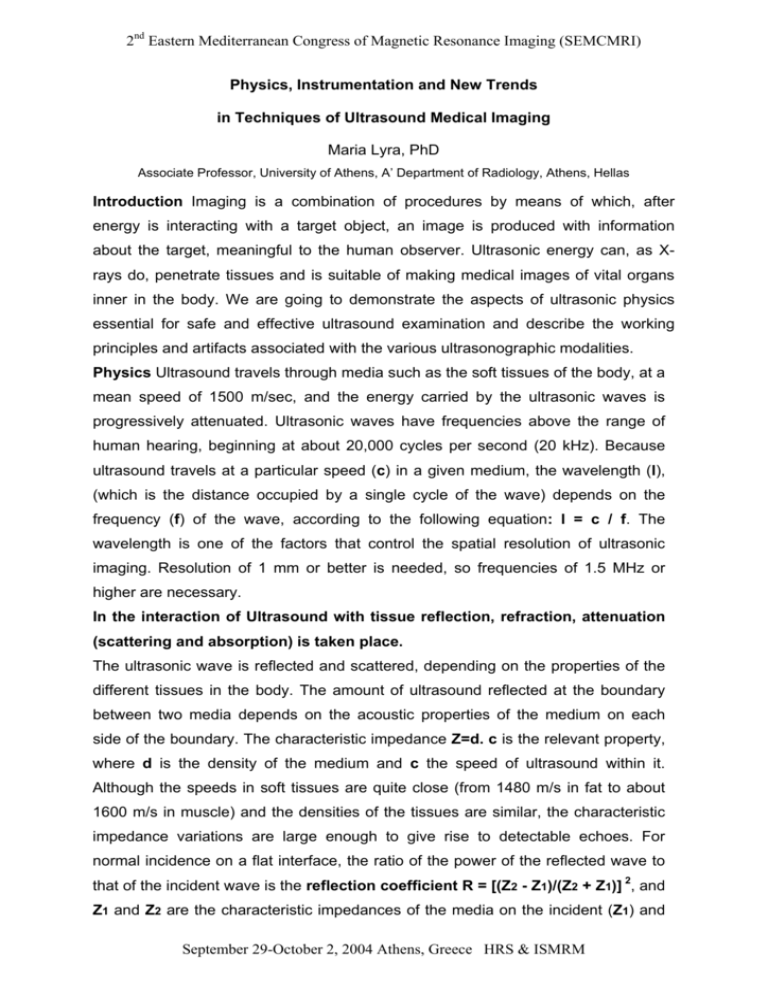
2nd Eastern Mediterranean Congress of Magnetic Resonance Imaging (SEMCMRI) Physics, Instrumentation and New Trends in Techniques of Ultrasound Medical Imaging Maria Lyra, PhD Associate Professor, University of Athens, A’ Department of Radiology, Athens, Hellas Introduction Imaging is a combination of procedures by means of which, after energy is interacting with a target object, an image is produced with information about the target, meaningful to the human observer. Ultrasonic energy can, as Xrays do, penetrate tissues and is suitable of making medical images of vital organs inner in the body. We are going to demonstrate the aspects of ultrasonic physics essential for safe and effective ultrasound examination and describe the working principles and artifacts associated with the various ultrasonographic modalities. Physics Ultrasound travels through media such as the soft tissues of the body, at a mean speed of 1500 m/sec, and the energy carried by the ultrasonic waves is progressively attenuated. Ultrasonic waves have frequencies above the range of human hearing, beginning at about 20,000 cycles per second (20 kHz). Because ultrasound travels at a particular speed (c) in a given medium, the wavelength (l), (which is the distance occupied by a single cycle of the wave) depends on the frequency (f) of the wave, according to the following equation: l = c / f. The wavelength is one of the factors that control the spatial resolution of ultrasonic imaging. Resolution of 1 mm or better is needed, so frequencies of 1.5 MHz or higher are necessary. In the interaction of Ultrasound with tissue reflection, refraction, attenuation (scattering and absorption) is taken place. The ultrasonic wave is reflected and scattered, depending on the properties of the different tissues in the body. The amount of ultrasound reflected at the boundary between two media depends on the acoustic properties of the medium on each side of the boundary. The characteristic impedance Z=d. c is the relevant property, where d is the density of the medium and c the speed of ultrasound within it. Although the speeds in soft tissues are quite close (from 1480 m/s in fat to about 1600 m/s in muscle) and the densities of the tissues are similar, the characteristic impedance variations are large enough to give rise to detectable echoes. For normal incidence on a flat interface, the ratio of the power of the reflected wave to that of the incident wave is the reflection coefficient R = [(Z2 - Z1)/(Z2 + Z1)] 2, and Z1 and Z2 are the characteristic impedances of the media on the incident (Z1) and September 29-October 2, 2004 Athens, Greece HRS & ISMRM 2nd Eastern Mediterranean Congress of Magnetic Resonance Imaging (SEMCMRI) other side of the interface (Z2). The attenuation of ultrasound increases with frequency. Then the penetration of ultrasound into the body decreases as the frequency is increased. In pulse-echo ultrasonic techniques, brief pulses of ultrasound are transmitted into the body, and echoes are detected from reflecting and scattering structures. Small structures scatter rather than reflect Ultrasound. Besides the echoes from soft tissues, the interfaces of soft tissues with bone or with gas are of practical relevance to ultrasonic imaging. Bone has high characteristic impedance, whereas that of gas is low. Ultrasound, in both, is largely reflected at the interface; so the penetration beyond bone and gas is limited. Ultrasound Production In Medical Ultrasonics, piezoelectric ceramics are generally used to convert between electrical energy and mechanical vibrations. A piezoelectric transducer can operate both as a transmitter and as a receiver of ultrasonic waves. Focusing of a transducer can be achieved and is useful for the optimum imaging at a certain depth in medium. A pulse of ultrasound is transmitted into the body and gives rise to echoes detectable by the same transducer as that from which the beam originated. Doppler Effect The frequency of ultrasound received after reflection by a stationary target is the same as that of the ultrasonic transmitter. If the target has a component of motion along the axis of the ultrasonic beam, the Doppler effect shifts the frequency of the received signal, by fd: fd = 2v (cos θ) f/c where fd is the difference between the received and the transmitted ultrasonic frequencies, v is the speed of the target, and θ is the angle between the directions of the ultrasonic beam and the movement of the target. Doppler Imaging By pulsed Doppler system, depth information can be obtained and the position of the Doppler sample volume along the ultrasonic beam can be chosen. The detectable shift frequency has an upper limit, as in sampling theory the sampling frequency should be more than twice the sampled frequency–the Nyquist criterion-; Doppler pulse-echo imaging allows one to visualize and measure flow or motion. The Doppler signals from targets moving can be analyzed. On a color Doppler image, two-dimensional blood flow information is superimposed on traditional real-time pulse-echo gray-scale image with the corresponding flow measurements coded by color, so that the observer can perceive flow information . Contrast Agents Specialized contrast agents have broaden the clinical applications of diagnostic ultrasound. Bubbles agents are small enough to cross over capillary September 29-October 2, 2004 Athens, Greece HRS & ISMRM 2nd Eastern Mediterranean Congress of Magnetic Resonance Imaging (SEMCMRI) beds, and they can last long enough to allow venous injection to produce contrast effects in the systemic circulation. Bubbles scatter ultrasound not only at the same frequency as that of the transmitted pulses, but also at twice this frequency. This concept is the basis of harmonic imaging with contrast agents, which is associated with greatly enhanced sensitivity to small volumes of low-velocity blood flow. Artifacts Numerous artifacts can occur in pulse echo imaging. Many of these artifacts are due to the physics of the image-forming process. Shadowing or enhancement of echoes from beyond a structure is due to attenuation higher or lower than that of the surroundings. Reverberation arises from multiple echoes associated with strong reflectors oriented normally to the beam. Strong reflectors, lying obliquely to the direction of the beam, cause duplications of image features, whereas side lobes of the beam lead to misregistration. Pulsed Doppler systems are prone to the same artifacts as pulse-echo systems, although the problems may not be so immediately obvious. In addition, aliasing of Doppler signals occurs when the pulse repetition rate is less than twice the Doppler shift frequency. Despite the continued improvement and sophistication of ultrasound technology, artifacts have not disappeared. Some of the newer transducer shapes and geometry can cause increased artifact problems. Some artifacts can help in certain circumstances; others appear in the wrong place at the wrong time and may lead to misdiagnosis. Power Doppler is much more sensitive in detecting the presence and volume of flow and not the velocity and flow direction. In power Doppler, the brightness of the color is related to the number of blood cells moving, not to their velocity. Power Doppler is even more sensitive to artifactual motion such as movement of the transducer. With power Doppler, slow flow can be detected even in small vessels, such as in the periphery of the kidney or lymph nodes. Exquisite images can be made of the neonatal cerebral circulation. Volume sonography requires integrating a series of two-dimensional image slices to develop a 3-dimensional impression of underlying anatomic or pathologic features. Volume visualization enhances the diagnostic process by providing better delineation of complex anatomic structures and pathologic processes. Dynamic motion can be reviewed to assess fine movement; the valves of the heart can be artificially “stopped” to make measurements. Blood flow visualization is 3-dimensional and acquisition of volume data can be reviewed after the patient has left the facility. September 29-October 2, 2004 Athens, Greece HRS & ISMRM 2nd Eastern Mediterranean Congress of Magnetic Resonance Imaging (SEMCMRI) Intraoperative ultrasound benefits include information not seen on preoperative imaging, road-mapping to identify vascular and nonvascular structures, guidance & confirmation of needle and catheter insertion & placement and more. The basic intra operative ultrasound format is grey-scale imaging, but colour, power, and pulsed Doppler may add physiologic data on the grey-scale anatomic image. Transducer frequencies used, vary from 5 to 10 MHz, depending on the organ imaged and the depth of the lesions. Higher-frequency transducers give better resolution but poor depth penetration. I- or T-shaped transducers are mostly used intra-operatively. Safety Diagnostic Ultrasound has been in use since the late 1950's.According to AIUM, no confirmed biological effects on patients or operators, caused by exposure at intensities of diagnostic Ultrasound Instruments, have ever been reported. 1. If the frequency doubles, the wavelength A. Doubles B. Halves C. Increases by 4 times D. Does not change Answer: B, wavelength is inversely proportional to frequency. 2. Lateral resolution is most closely associated with A. Transducer size B. Transducer shielding C. Beam Width D. Pulse duration Answer: C, beam width does depend on transducer size as well as on frequency & focusing. 3. The scanning speed and frame rate in a pulse-echo instrument are limited mainly by A. Pulser heating B. Amplifier heating C. Sound travel time D. Sound attenuation Answer: D, is limited by sound travel time; the greater the image depth, the slower the scanning speed. 4. The strength of the Doppler signal from flowing blood is most closely related to A. The area of the Ultrasound beam B. The shape of the red blood cells C. The speed at which the blood is moving D. The number of red blood cells in the beam Answer: D, the strength is related to the no of red blood cells contributing to the Doppler signal. 5. The pixel data displayed on the image obtained by a color flow instrument are most closely associated with A. Peak Doppler frequency B. Mean Doppler frequency C. Lowest Doppler frequency D. Doppler frequency Spectrum Answer: B, the color processor estimates the mean Doppler frequency for each pixel location. September 29-October 2, 2004 Athens, Greece HRS & ISMRM

![Jiye Jin-2014[1].3.17](http://s2.studylib.net/store/data/005485437_1-38483f116d2f44a767f9ba4fa894c894-300x300.png)
